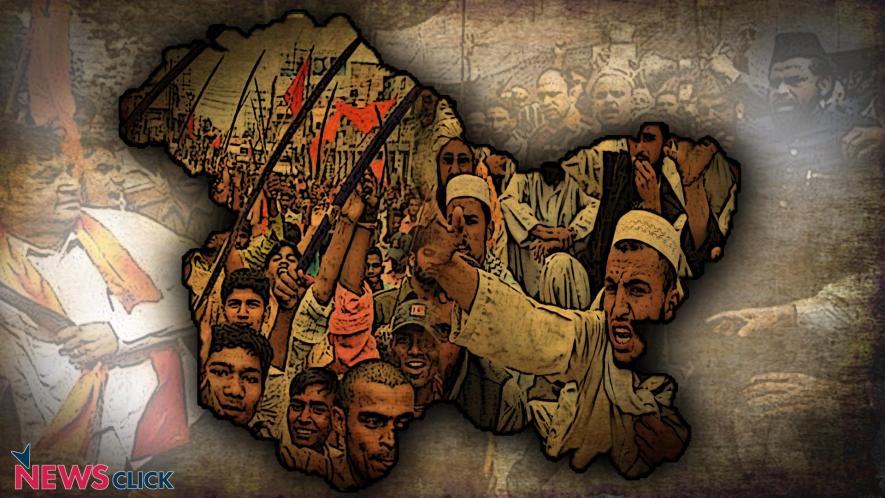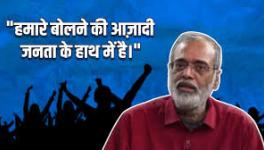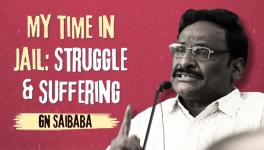Right Wing Groups are Working Overtime to Divide Jammu on Communal Lines

Newsclick Image by Sumit
Jammu, being a pluralistic society, today is on the edge. Hatred is being spread within communities, regions, religions and castes. A design is being orchestrated that might lead to communal clashes. And if these communal clashes start, it might end up being the worst ever in the history of the country because of the demographic situation of the Jammu region.
Fringe groups have chosen to spearhead a bigoted, communal and Islamophobic campaign of “demographic change” in the province and are instrumental in inflicting open injuries to Hindu-Muslim sentiments in the state.
These fringe groups are visibly getting success because they have been using the historic divide between Jammu and Kashmir, using the discrimination theory and talking about the Dogra pride without going into the dark chapters of the history.
As has been the traditions, Muslims in general and nomads – the Bakkarwal or Gujjars – in particular, have become more vulnerable because they were not as protected. The Hindu Ekta Manch – which recently came into existence allegedly to provide political patronage to the perpetrators of eight-year-old tribal girl, who was abducted on January 10, held captive for a week and raped before being murdered – has been successful in convincing people that the Chief Minister Mehbooba Mufti-led government in Jammu and Kashmir is providing “administrative immunity to the land grabbers and bovine smugglers of a particular religion in Jammu province”.
The ruling People’s Democratic Party (PDP), a Kashmir-based separatist party as they call it, is taking decisions driven by a “majoritarian, communal-fascist and hegemonic agenda of destroying the demography and cultural identity of Hindus/Sikhs/Dogras of Jammu province”.
“Jammu is the land of Hindus (Dogras and Sikhs) but the government wants to turn it into a Muslim-majority region like Kashmir. Giving shelter to Rohingya refugees – who are ticking time bombs and a threat to the national security, funded subsidised colonisation of the province and taking decisions in favour of tribal population who are land grabbers and infamous of bovine smuggling and slaughter are parts of the Kashmir-based separatist party’s agenda,” Advocate Ankur Sharma, who is associated with the Hindu Ekta Manch, told Newsclick in an interview.
He further said that the Kashmiri Muslims “funded by pan Islamic organisations” are purchasing land here on higher rates with an aim to “change the demography of the area”. “But we will let them do that. We are making people aware of the nefarious design of the separatist party’s government. We are also making efforts and in talks with the BJP (the Bharatiya Janata Party, which is a partner of the coalition government in Jammu and Kashmir) that delimitation happens in Jammu as soon as possible on religious lines so that we can double the number of constituencies and can send a sizable chunk of Hindu MPs and MLAs in Parliament and the state Assembly respectively,” he said.
Asked why the Hindu Ekta Manch wants delimitation of the Jammu region on religious lines, he said it is because the Hindu community here feels “prosecuted” and living with “fear”.
Jammu society was very liberal and secular. Through the 1970s, 1980s and even post militancy, the region never really had problems to this extent. There were provocations, but Jammu did not succumb. One would have said that the society in Jammu has matured enough.
If one goes back to pre or post-1947, Jammu’s socio-political narrative was very much nuanced. It has alternated between very communal and extremely accommodating. After 1947, there were a large number of refugees (from Pakistan-occupied Kashmir, West Pakistan and even before that there were settlers who came here during Maharaja Hari Singh’s time from Punjab and post militancy, Kashmiri Pandits came) whom Jammu accommodated with an open heart.
The year 1947 was a major year of bloodshed in Jammu province. The kind of communal violence that took place here triggering massive displacement was one of the biggest of that year.
Anuradha Bhasin Jamwal, political analyst and executive editor of an English daily – Kashmir Times, says Jammu has very strange and inexplicable ups and downs which makes her wonder whether there has been a latent feeling of communalism.
“Is it that the majoritarian sentiment that is coming out? There is a silent majority which is opposed to such communal ideology but they are silent. Why are they sitting back? These are some questions I am grappling with. There is the whole crescendo of communalism that is increasing, especially after 2008. In 2008, we had Amarnath land agitation, which began from Kashmir against the transfer of government land to the Amarnath Shrine Board that is headed by the governor. As per the state laws, you cannot transfer it to the non-state subject which is the person who is heading the board. That was the opposition. The opposition was not to create an infrastructure for the pilgrims or for facilitating the pilgrimage. But the Right wing propaganda that the Kashmiris are opposing the pilgrimage worked. It got a boost and there was a counter agitation that time in Jammu for three months to press the government to hand over the land to the Shrine Board. It assumed the shape of Jammu Vs Kashmir that eventually turned out to be communally polarised and divisive because it became a euphemism for the Hindu-Muslim divide,” she told Newsclick.
She said there was a lot of potential at that time for a communal violence. In fact, the riots broke out in few pockets. “The nomads – the Bakkarwal or Gujjar – became more vulnerable because they were not as protected. The Muslim civil society of Jammu openly came out to pacify by convincing the Hindu right-wing groups, which was spearheading the campaign, that they are with them since the issue was attached to your religious sentiments. That helped cool down the situation temporarily but I am not sure whether it helped cool down the discourse,” she said
When asked about the history of fringe groups active in the region, she added, “The RSS (Rashtriya Swayamsevak Sangh) has always been active in the region. Right now, I won’t be able to give you the evidence of the Hindu Ekta Manch’s association with the RSS. But if you go back, there was a group called Praja Parishad quite active here. It was an offshoot of the RSS. In 2008, another group propped up with the name Sangharsh Samiti, which was spearheading the entire agitation of the Amarnath land issue. Many RSS leaders were part of it. Also, there was Sanatan Sabha. All these groups are interlinked in one way or the other. Every new issue that comes up here, we hear new names being floated.”
Asked about the validity of the allegation of the demographic change in the region, Bhasin said, “Again I will go back to 1947 when there was the butchery of Muslims that changed the entire demography of the Jammu region. My father, who was active in students’ politics those days, used to tell us that there was an officer in the Maharaja Army who played an instrumental role in the massacre of Muslims and that there was a deliberate attempt to change the entire political demography of the region so that the entire discourse could change.”
Interestingly, the Opposition appears to present a counter-narrative of the fringe groups to prevent the society getting divide on communal lines.
When Newsclick spoke to Devender Singh Rana, provincial president of the National Conference, he said his party leadership is working hard to bridge the gaps between the communities, region and religion.
“We have a very strong feeling that the present government, having failed to deliver its promises, is orchestrating an ecosystem where nothing other than hatred can work to counter their failures. With elections of Parliament round the corner, there could be a larger design to make Jammu and Kashmir a theatre for the entire country. So, there could be all possibilities that this hate atmosphere that is being created in Jammu and Kashmir is primarily to feed the interests of a political party across the country,” he said and added that “we apprehend that the state orchestrated design might lead to communal clashes. And once these communal clashes start, they might end up being the worst ever in the history of the country because of the demographic situation of the Jammu region”.
The National Conference – he said – has been “repeatedly and vehemently” coming out with a narrative of co-existence, brotherhood and plurality with secularism. “We are consistently trying to press upon people to rise above political interests, keep politics at bay and ensure Jammu and Kashmir stays together. There are elements on either side. We – in fact – feel that the PDP is trying to prop up one community and the BJP is trying to create another community with a design that there is an eye ball to eye ball confrontation and the confrontation gives them benefit. But they do not realise that they are playing with fire. If the flame starts, it will engulf everyone and then it will be free for all,” he added.
Kashmir is on the boil, Jammu is simmering and Ladakh is facing the heat. The voices of trifurcation are getting strength by default. If a party talks about greater autonomy, there should also be words on the grant of regional autonomy to different regions of the state to ensure equitable development to fulfil the aspiration of people.
Get the latest reports & analysis with people's perspective on Protests, movements & deep analytical videos, discussions of the current affairs in your Telegram app. Subscribe to NewsClick's Telegram channel & get Real-Time updates on stories, as they get published on our website.























